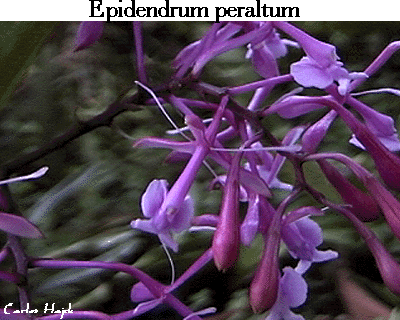

Epidendrum peraltum Schltr. 1920 GROUP Pseudepidendrum SUBGROUP Porphyreum
Photo by Carlos Hajek and his Peruvian Orchid Page
TYPE Drawing by © Jimenez, Hágsater & E.Santiago and The AMO Herbario Website


 LATE
LATE to EARLY
to EARLY 
Common Name
Flower Size 1" 2.5 cm
Found in Colombia, Ecuador, Peru? and Bolivia? on the westetrn side of the Andes in the lower reaches of wet cloud forests as a large sized, caespitose, cool to cold growing epiphyte or terrestrial at elevations of 1850 to 3100 with a simple, reed-like, terete at the base, the basal half covered by non-foliar, tubular, acuminate scarious sheaths becoming fibrous with time, laterally compressed towards the apex, erect, straight stem carrying 11 or more, distributed along the apical half of the stem, distichous, articulate, erect-spreading, unequal in size, the basal one smaller, oblong to oblong-elliptic, ascending, thin-textured, acute and recurved apically, margin entire, basally clasping leaves that blooms in the late winter and early spring on a terminal, without a spathe, arising on a mature stem, peduncle thin, laterally compressed, straight, covered by 2 tubular, scarious, acuminate, partly imbricating bracts, rachis terete, thin, paniculate with 5-8 racemes, the basal ones themselves branching, spreading, lax, each 5 to 6 flowered, each provided with a narrowly triangular, acuminate bract at the base, erect, 4.8" [12 cm] long overall, successively several, to 90 flowered inflorescence with shorter than the ovary, narrowly triangular, acuminate, amplexicaul floral bracts and carrying resupinate, non-fragrant flowers.
"Epidendrum peraltum belongs to the GROUP Pseudepidendrum is characterized by caespitose plants, cane-like stems, acute to acuminate leaves, apical inflorescence, lacking a spathaceous bract, the petals filiform and the lip usually 3-lobed, with 3 parallel fleshy keels, the apical lobe often bifurcate, and the pollinia “bird-wing” type and SUBGROUP Porphyreum which has flowers colored reddish orange, deep purple or lilac-pink, the calli generally prominent, sometimes horn-like. The species is recognized by the large greenish yellow flowers tinged pink to totally dirty pink, sepals .56 to .64" x .14 to .16" [14 to 16 x 3.5 to 4 mm], lip with the lateral lobes strongly retrorse, the mid-lobe with a short isthmus, parallel sided, ending in a pair of strongly divaricate, linear lobes, column .52" [13 mm] long. Epidendrum capricornu Kraenzl. has somewhat shorter plants, the sepals dorsally purple-brown and ventrally yellowish, the lip bluish purple, with the mid-lobe deltate, and the apical pair of lobes horn-like. Epidendrum porphyreum Lindl. has purple colored flowers, the disc white, sepals .53 to .6" x .2 to .26" [13 to 15 x 5 to 6.5 mm]; the lateral lobes of the lip are ovate-dolabriform, not retrorse, and the mid-lobe has a pair of triangular, slightly divaricate lobes. Epidendrum laeve Lindl. [Syn E ionodesme] has somewhat smaller flowers, violet to dark pink, with the calli white; sepals .4 to .44" x .12 to .16" [10 to 11 x 3 to 4 mm]; lateral lobes of the lip sub-quadrate-dolabriform, only slightly retrorse, column .32 to .34" [8 to 9 mm] long. Epidendrum arnoldi Schltr. has smaller lilac-pink flowers, sepals 8 mm long, lateral lobes of the lip dolabriform, and the column ,24" [6 mm] long. Epidendrum lopezii Hágsater has the largest flowers, sepals .68 to .74" [17 to 19 mm] long, the lip is greenish white with a deep purple splotch in front of the column, and the mid-lobe (which is as long as the lateral lobes), forms a pair of slightly divaricate, apical lobes." Hagsater etal 2010
Synonyms Epidendrum altissimum F. Lehm. & Kraenzl. 1899
References W3 Tropicos, Kew Monocot list , IPNI ; Repert. Spec. Nov. Regni Veg. Beih. 7: 250 Schlechter 1920; Icones Planetarum Tropicarum plate 249 Dodson 1980 drawing fide; The Illustrated Encyclopedia of Orchids Pridgeon 1992 as E altissimum photo fide; Manual Of Orchids Stewart 1995 as E altissimum; Icones Orchidacearum Peruviarum Plate supplemental Bennett & Christenson 1998 drawing ok; Icones Orchidacearum 3 Plate 348 Hagsater 1999 see recognition Section; Icones Orchidacearum 4 Plate 410 Hagsater 2001 see recognition section; Icones Orchidacearum 4 plate 416 Hagsater & Salazar 2001 see recognition section; Icones Orchidacearum 4 plate 463 Hagsater & Salazar 2001 see recognition section; Orchids of Bolivia Vol 2 Laelinae Vasquez and Ibisch 2004; Orchid Species of Peru Zelenko Bermudez 2009 photo fide; Icones Orchidacearum 13 Plate 1304 Hagsater 2010 see recognition section; Icones Orchidacearum 13 Plate 1305 Hagsater 2010 see recognition section; Icones Orchidacearum 13 Plate 1309 Hagsater & Santiago 2010 See Recognition section; Icones Orchidacearum 13 Plate 1328 Hagsater 2010 see recognition section; Icones Orchidacearum 13 Plate 1339 Hagsater 2010 see recogntion section; Icones Orchidacearum Part 13 Plate 1369 Hagsater 2010 drawing fide; Icones Orchidacearum 14 Plate 1432 Hagsater & Santiago 2013 See recognition section; Orchids of the Department of Valle De Cauca Colombia Vol 2 Kolanowska, Hagsater etal. 2014 photo drawing fide; Icones Orchidacearum 16[1] Plate 1610 Hagsater & Santiago 2018 See recognition section;
--------------------------------------------------------------------------------------------------------------------------